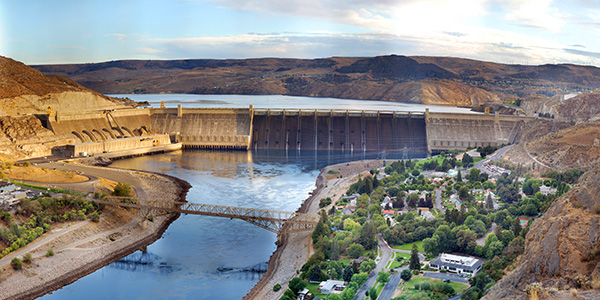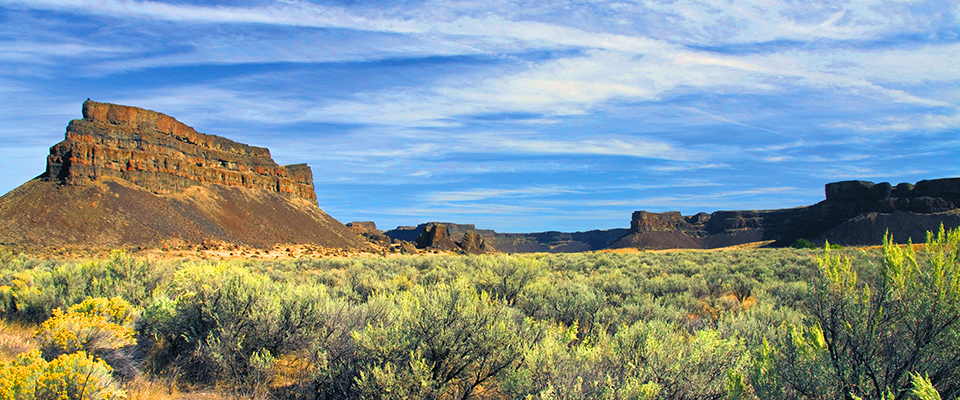Spotlight: Coulee Corridor
Take a beautiful byway that traverses landscapes carved by glaciers
The Coulee Corridor Scenic Byway is a compelling route that meanders 150 miles from Connell to Omak. Along this journey, travelers will discover numerous stops for recreation, relaxation and adventure.
The eastern Washington corridor follows the Columbia River’s Ice-Age glacier path, where landscapes include semi-arid desert, pothole lakes, wetlands and canyons. The coulees, for which the corridor is named, are deep ravines carved into the bedrock by post-glacial flooding. The descendants of early inhabitants make up the Colville Confederated Tribes, and their legacy is memorialized at the Tribal Museum in Coulee Dam.
Coulee Corridor is a birder’s dream come true. More than half of the 346 species recorded annually in Washington can be spotted along this route. From sandhill cranes to black-crowned night herons to bald eagles, birdwatching opportunities abound year-round.
The community of Connell was first established as a railroad stop in 1883. It preserves its history in the Connell Heritage Museum through a collection of archival photos and documents. Summertime travelers are welcome to cool off at the city’s Pioneer Park Pool.
Othello is well-known for its springtime sandhill crane festival, which features education sessions and tours for crane viewing. But visitors are also welcome to tour the Old Hotel Art Gallery and to drop by one of the city’s many other community celebrations, including the annual Adams County Fair and Rodeo.
Potholes State Park near Othello sits adjacent to Potholes Reservoir, which offers 6,000 feet of freshwater shoreline surrounded by desert and freshwater marsh terrain. Hike three miles of trails through the park, or take a boat out on the water from one of four ramps. Freshwater fishing in the reservoir is permitted with a state license.

Getty Images/iStockphoto
Getting Creative in Moses Lake
There’s plenty to explore in the town of Moses Lake. The Moses Lake Museum & Art Center is home to a collection of Native American artifacts, local history exhibits and fine art pieces, as well as a metal sculpture of a giant Columbian mammoth.
A local water park provides a cool respite on warm summer days, as do the Moses Lake Water Trails. The trails run through Moses Lake, which is 18 miles long and boasts more than 120 miles of shoreline. Kayaks, canoes and other non-motorized boats are ideal for exploring the parks along the trails.
Take a plunge into miraculous mud at Soap Lake, a mineral lake with a neighboring resort community touting the health benefits of getting down and dirty. Native American tribes took advantage of the mineralized waters and mud, and visitors flock to the shores of Soap Lake for the same reason. Once you’re squeaky clean again, be sure to visit the Soap Lake Art Museum and Healing Water Gallery to see works by local artists, grab a bite to eat at a local European deli and browse a quirky antique store.
Dry Falls State Park is an arid oasis dotted with freshwater lakes. Once home to a massive waterfall, now all that remains is a 400-foot-high cliff that’s 3.5 miles wide. The lakes still support wildlife, fishing and boating opportunities, and birdwatching. Golfers hit the links at a nine-hole golf course, and hikers traverse trails around geologic features and desert plants and animals.
In the town of Coulee City, an historic walking tour tells the story of the Grand Coulee Dam’s construction and its impact on the people who lived there. Banks Lake is a warm-water fishery for black crappie, bluegill, channel catfish and largemouth bass, as well as rainbow trout and lake whitefish. Ice-fishing is popular in winter here, too.
A Steamboat and a Ski Loop
The north end of the lake is the site of Steamboat Rock State Park, with a sandy swimming area and several miles of horse trails, as well as a hiking trail to Northrup Lake. The Northrup Canyon hike features views of basalt cliffs and the remains of an old homestead.
Two miles above Grand Coulee Dam is the city of Grand Coulee. The dam attracts thousands of guests to explore its visitor center and to stay later on summer evenings for a laser light show. The city is home to a quirky collection of windmill folk art crafted by Emil Gehrke, a late resident of nearby Electric City. More than 120 windmills populate the windmill garden, which is open to visitors.
Native American history and a legacy of mining form the backbone of Nespelem, a town originally founded by Yakima tribe leader Chief Kamiakin. Today, the small town rests in the borders of the Colville Indian Reservation and is home to the Colville Tribal Cultural Center and an historic Nez Perce Cemetery.
The city of Omak takes advantage of its high-desert surroundings to indulge in year-round recreation. Camping, fishing, skiing and snowmobiling are among the many opportunities to get out and enjoy the scenery. The Loup Loup Ski Bowl is a family-friendly winter destination for downhill skiing and snow tubing. On a rainy day, pop into Colville Tribal Casinos and roll the dice for an hour or two. Finally, toast to a fun-filled trip in the tasting room at Rockwall Cellars.

Gregg M. Erickson
Life on Lake Roosevelt
No trip to the Coulee Corridor would be complete without visiting the Lake Roosevelt National Recreation Area. The centerpiece is the 130-mile lake that was created in 1941 after the completion of the Grand Coulee Dam. Named after President Franklin D. Roosevelt, the recreation area provides lots of opportunities for boating, swimming, fishing, canoeing, hunting.
Lovers of history should tour nearby Fort Spokane, built on land that was a gathering place for thousands of for native tribes fishing on the rapids of the Spokane River. In 1880, the U.S. Army established the fort above the confluence of the Spokane and Columbia Rivers to safeguard trading and settlements. Later, the property became an Indian boarding school and tuberculosis hospital.
Visitors to the site can learn about the unique uniforms and weapons involved on the “Indian Frontier.” While touring the fort, visitors can peruse artifacts left by military units and by students of the school. The historic buildings are open during the summer season, and short walking trails around the grounds allow hikers to explore the surrounding wilderness.
Turn another chapter in history by visiting St. Paul’s Mission, also located in the Roosevelt National Recreation Area. The mission’s history stretches back to the mid-1800s when Catholic missionaries traveled the region to convert the Native Americans to Christianity. In 1840, Father DeSmet, a Belgian Jesuit, established a permanent mission near Kettle Falls for the more than 800 Indians who assembled in the area to fish.
Over the years, the building deteriorated, but it was restored in 1939 and still stands.
For More Information






